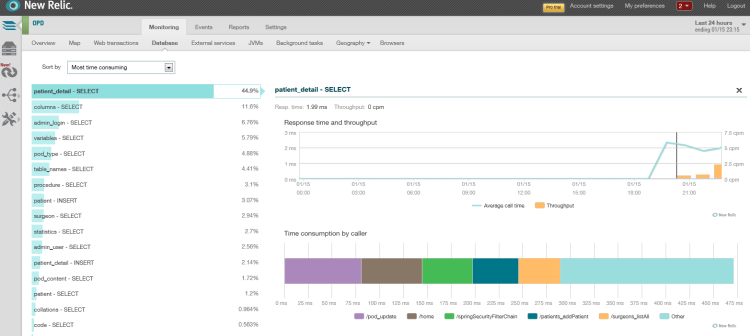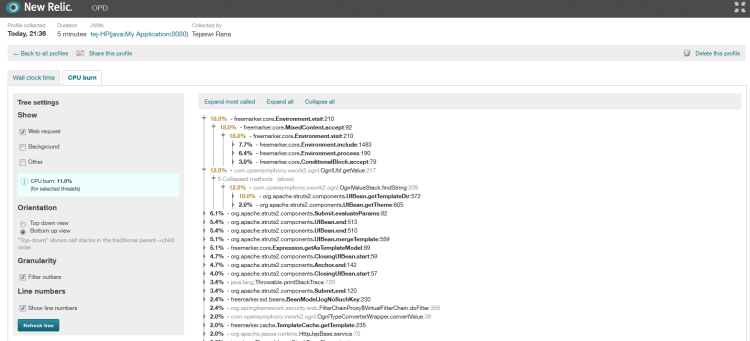If you are working on CentOS and MySQL, you will want to make sure you verify your connection after the application has been left untouched for some time. Without trying to verify connection you'll end up with a stack trace complaining "Could not open Hibernate Session...". Surprisingly this does not happen on Windows with the same configuration. I am using commons-dbcp.jar and commons-pool.jar. Here is my configuration -
<!-- Define dataSource to use -->
<bean id="dataSource" class="org.apache.commons.dbcp.BasicDataSource">
<property name="driverClassName" value="${hibernate.jdbc.driver}" />
<property name="url" value="${hibernate.jdbc.url}" />
<property name="username" value="${hibernate.jdbc.user}" />
<property name="password" value="${hibernate.jdbc.password}" />
</bean>
<!-- The sessionFactory will scan the domain objects and their annotated relationships. -->
<bean id="sessionFactory" class="org.springframework.orm.hibernate3.annotation.AnnotationSessionFactoryBean">
<property name="dataSource" ref="dataSource" />
<!-- Packages to scan probably works but I will use xml definitions -->
<!--
<property name="packagesToScan">
<list>
<value="com.d2.tej.domain" />
<value="com.d2.tej.dao.impl" />
<value="com.d2.tej.service.impl" />
</list>
</property>
-->
<property name="annotatedClasses">
<list>
<value>com.OrthoPatientDirect.OPDJAR.core.domain.AdminUser</value>
<value>com.OrthoPatientDirect.OPDJAR.core.domain.AdminLogin</value>
<value>com.OrthoPatientDirect.OPDJAR.core.domain.Code</value>
<value>com.OrthoPatientDirect.OPDJAR.core.domain.Patient</value>
<value>com.OrthoPatientDirect.OPDJAR.core.domain.PatientDetail</value>
<value>com.OrthoPatientDirect.OPDJAR.core.domain.PodType</value>
<value>com.OrthoPatientDirect.OPDJAR.core.domain.PodTypeContent</value>
<value>com.OrthoPatientDirect.OPDJAR.core.domain.Practice</value>
<value>com.OrthoPatientDirect.OPDJAR.core.domain.Procedure</value>
<value>com.OrthoPatientDirect.OPDJAR.core.domain.Surgeon</value>
<value>com.OrthoPatientDirect.OPDJAR.core.domain.Subscription</value>
</list>
</property>
<property name="schemaUpdate" value="true" />
<property name="hibernateProperties">
<props>
<prop key="hibernate.connection.isolation">2</prop>
<prop key="hibernate.bytecode.use_reflection_optimizer">true</prop>
<!-- <prop key="hibernate.dialect">org.hibernate.dialect.SQLServerDialect</prop>-->
<prop key="hibernate.dialect">org.hibernate.dialect.MySQLInnoDBDialect</prop>
<!-- org.hibernate.dialect.MySQLMyISAMDialect, org.hibernate.dialect.MySQLDialect, org.hibernate.dialect.MySQLInnoDBDialect -->
<prop key="hibernate.jdbc.batch_size">10</prop>
<prop key="hibernate.max_fetch_depth">2</prop>
<prop key="hibernate.show_sql">true</prop>
<prop key="hibernate.format_sql">true</prop>
<prop key="hibernate.hbm2ddl.auto">update</prop>
<!--connection pool-->
<prop key="hibernate.dbcp.maxActive">10</prop>
<prop key="hibernate.dbcp.whenExhaustedAction">1</prop>
<prop key="hibernate.dbcp.maxWait">20000</prop>
<prop key="hibernate.dbcp.maxIdle">10</prop>
<!-- prepared statement cache-->
<prop key="hibernate.dbcp.ps.maxActive">10</prop>
<prop key="hibernate.dbcp.ps.whenExhaustedAction">1</prop>
<prop key="hibernate.dbcp.ps.maxWait">20000</prop>
<prop key="hibernate.dbcp.ps.maxIdle">10</prop>
<!-- optional query to validate pooled connections:-->
<prop key="hibernate.dbcp.validationQuery">select 1</prop>
<prop key="hibernate.dbcp.testOnBorrow">true</prop>
<prop key="hibernate.dbcp.testOnReturn">true</prop>
</props>
</property>
<!--If you want to configure any listeners for any event this is the place to do. -->
<!--
<property name="eventListeners">
<map>
<entry key="delete">
<bean class="com.tej.core.hibernate.listener.DeleteEventListener" />
</entry>
</map>
</property>
-->
</bean>





